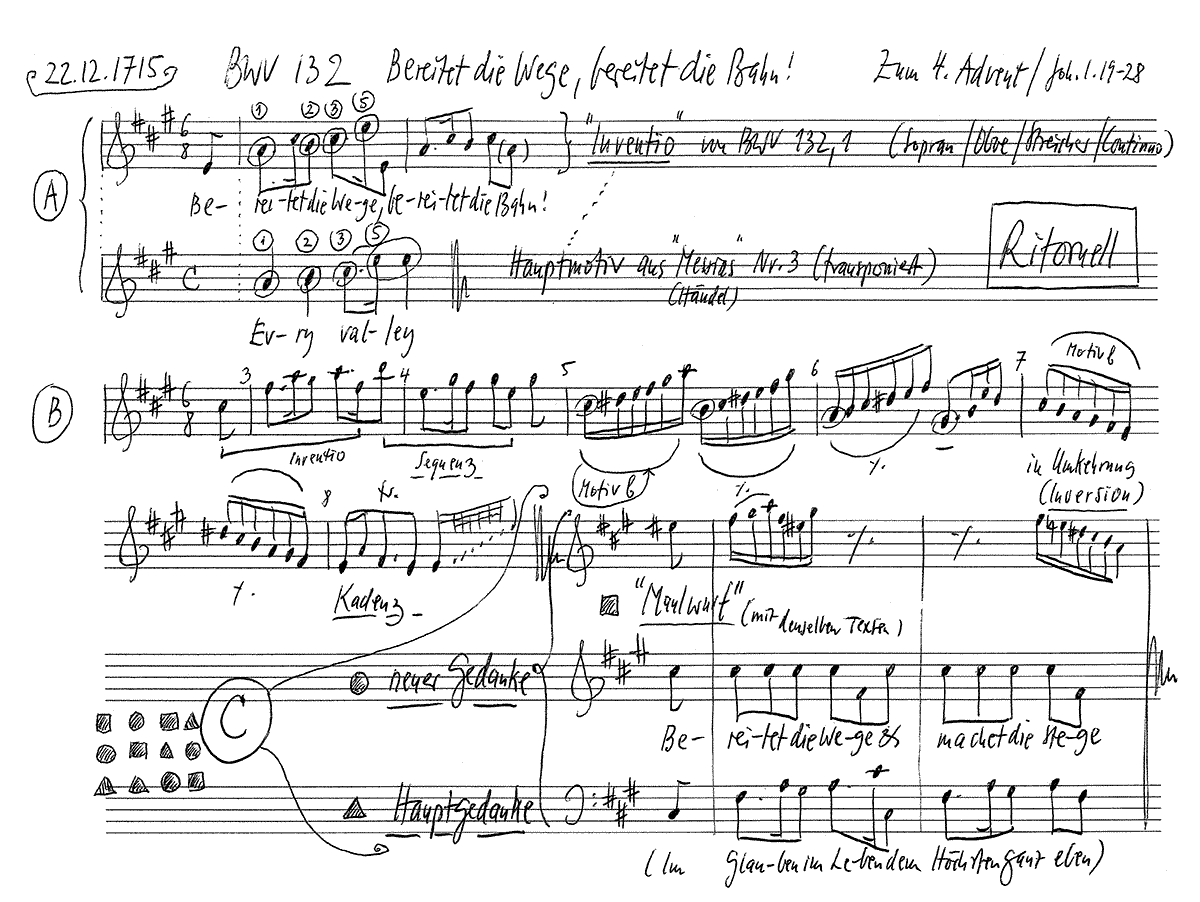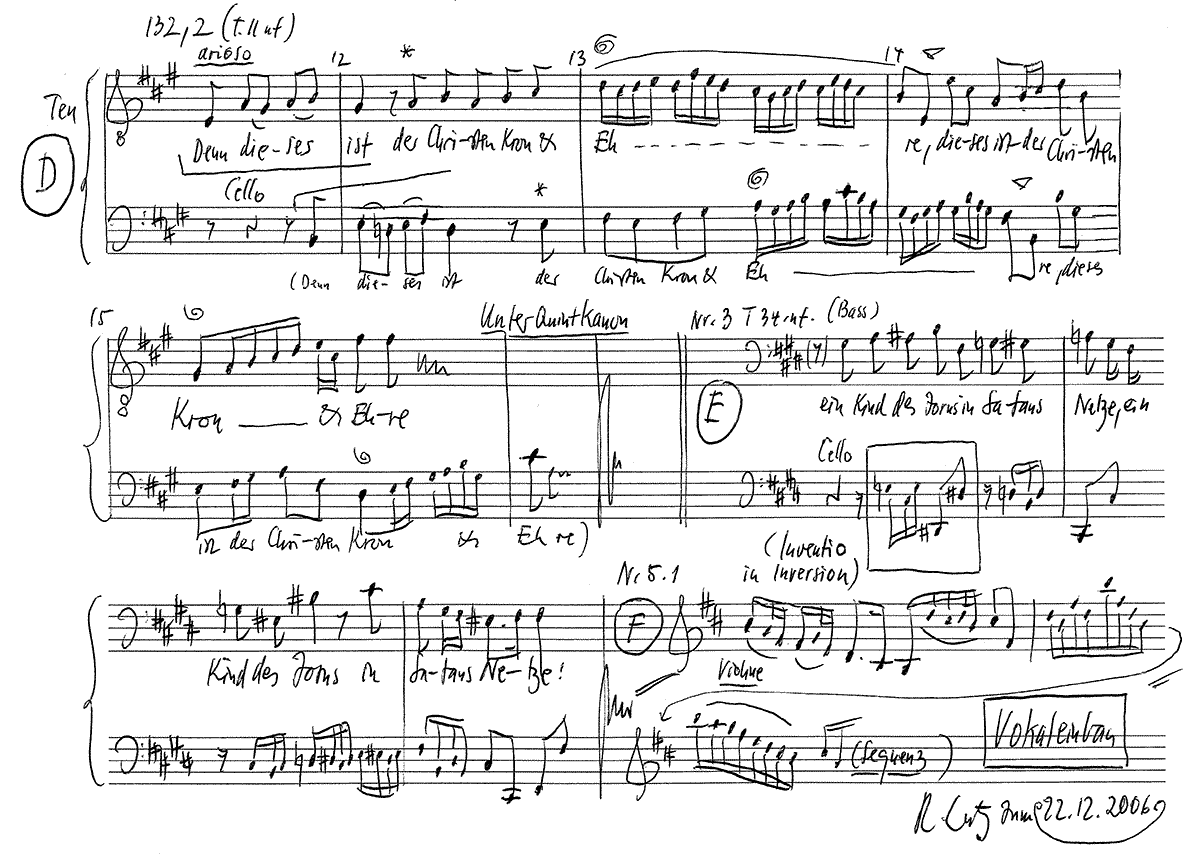Bereitet die Wege, bereitet die Bahn!
BWV 132 // For the Fourth Sunday in Advent
(Make ready the pathways, make ready the road!) for soprano, alto, tenor, bass, oboe, bassoon, strings and continuo.
Written in 1715, Bach’s Weimar cantata for the Fourth Sunday in Advent “Bereitet die Wege, bereitet die Bahn” (Make ready the pathways, make ready the road!) BWV 132 is scored primarily for four voices, strings and continuo. An oboe is also featured, particularly in the opening aria, where it provides a counterpart to the first violin and adopts a concertante role alongside the soprano voice.

Would you like to enjoy our videos ad-free? Subscribe to YouTube Premium now...
Workshop
Reflective lecture
Orchestra
Conductor
Rudolf Lutz
Violin
Renate Steinmann, Martin Korrodi
Viola
Susanna Hefti
Violoncello
Maya Amrein
Violone
Iris Finkbeiner
Oboe
Esther Fluor Baumberger
Bassoon
Susann Landert
Organ
Rudolf Lutz
Musical director & conductor
Rudolf Lutz
Workshop
Participants
Karl Graf, Rudolf Lutz
Reflective lecture
Speaker
Klara Obermüller
Recording & editing
Recording date
12/22/2006
Recording location
Trogen
Sound engineer
Stefan Ritzenthaler
Director
Meinrad Keel
Production manager
Johannes Widmer
Production
GALLUS MEDIA AG, Switzerland
Producer
J.S. Bach Foundation of St. Gallen, Switzerland
Librettist
Text No. 1–5
Salomo Franck, 1715
(Evangelisches Andachts–Opffer)
Text No. 6
Elisabeth Cruciger, 1524
(5th verse from “Herr Christ, der
einig Gottes Sohn”)
First performance
22 December 1715, Weimar
In-depth analysis
Written in 1715, Bach’s Weimar cantata for the Fourth Sunday in Advent “Bereitet die Wege, bereitet die Bahn” (Make ready the pathways, make ready the road!) BWV 132 is scored primarily for four voices, strings and continuo. An oboe is also featured, particularly in the opening aria, where it provides a counterpart to the first violin and adopts a concertante role alongside the soprano voice. As the organ and strings in Weimar were still tuned to the higher choir pitch, the oboe, set to chamber pitch, required a part transposed a minor third higher. Bach also added a bassoon part to the continuo, which nonetheless sets its own rhythmic accents. These differences, however, are only notated in the opening bars – the wellversed musician was expected to continue this for the entire movement. The joyful anticipation of the Messiah’s coming inspired Bach to compose a lively movement in which the soprano is called upon to sing virtually endless coloraturas. It is obvious that this is no ordinary road being prepared, but rather a path of faith stretching into eternity which the soprano and oboe can only follow with extraordinary effort. It is a testimony to the outstanding skill of the adult descant vocalists of the Weimar court that Bach even conceived of this composition. At the St Thomas school in Leipzig, Bach’s young pupils would scarcely have been able to master this soprano part.
The following tenor recitative is initially much more song-like, but soon melds into an arioso that echoes the coloraturas of the opening aria. The text explores the consequences Christ’s coming had for the lives of his followers and refers almost literally to Martin Luther’s theses which state that we cannot attain righteousness by works, but that our entire lives must be a testimony of faith and repentance.
The somewhat grim bass aria continues in a similar vein. Its thudding continuo prelude, reminiscent of organ pedal exercises, is punctuated by brief cadence figures whose pitch and weight perfectly mirror the speech pattern of the text “who art thou?” This probing question posed to John the Baptist in the gospel is heaved here at every single believer. This harsh interrogation is followed promptly by a confession, accompanied by the strings, of not having served God earnestly enough and even of having broken “Baptism’s bond”. In this movement, the libretto and music aim to transcend the ritualised text and reach out to the hearts of the listeners, a tone that also pervades the following alto aria “Christ’s own members, ah, consider”. Over a sparing bass line, a gentle and flowing violin melody unfolds that demands as much skill and virtuosity in its apparent effortlessness as does the alto solo. This aria, set in an elegiac B minor, is the last movement in Bach’s score – a highly unexpected end for a work beginning in A major. A surviving copy of the “Evangelischen Andachts-Opffer” by Salomo Franck, however, confirms that the verse “Us mortify through thy kindness” from Elisabeth Cruciger’s hymn “Herr Christ der einzig Gottes Sohn” should follow. It remains unknown whether this should have been performed as a simple congregational hymn, or whether Bach slipped the chorale movement from his cantata 164 (which closes with the same hymn) into the performance parts. The latter assumption is favoured among Bach scholars and is thus the version presented in this recording.
Libretto
1. Arie (Sopran)
Bereitet die Wege, bereitet die Bahn!
Bereitet die Wege
und machet die Stege
im Glauben und Leben
dem Höchsten ganz eben,
Messias kömmt an!
2. Rezitativ und Arioso (Tenor)
Willst du dich Gottes Kind und Christi Bruder nennen,
so müssen Herz und Mund
den Heiland frei bekennen.
Ja, Mensch, dein ganzes Leben
muss von dem Glauben Zeugnis geben!
Soll Christi Wort und Lehre
auch durch dein Blut versiegelt sein,
so gib dich willig drein!
Denn dieses ist der Christen Kron und Ehre.
Indes, mein Herz, bereite
noch heute
dem Herrn die Glaubensbahn
und räume weg die Hügel und die Höhen,
die ihm entgegen stehen!
Wälz ab die schweren Sündensteine,
nimm deinen Heiland an,
dass er mit dir im Glauben sich vereine!
3. Arie (Bass)
Wer bist du? Frage dein Gewissen,
da wirst du sonder Heuchelei,
ob du, o Mensch, falsch oder treu,
dein rechtes Urteil hören müssen.
Wer bist du? Frage das Gesetze,
das wird dir sagen, wer du bist,
ein Kind des Zorns in Satans Netze,
ein falsch und heuchlerischer Christ.
4. Rezitativ (Alt)
Ich will, mein Gott, dir frei heraus bekennen,
ich habe dich bisher nicht recht bekannt.
Ob Mund und Lippen gleich
dich Herrn und Vater nennen,
hat sich mein Herz doch von dir abgewandt.
Ich habe dich verleugnet mit dem Leben!
Wie kannst du mir ein gutes Zeugnis geben?
Als, Jesu, mich dein Geist und Wasserbad
gereiniget von meiner Missetat,
hab ich dir zwar stets feste Treu versprochen;
ach, aber ach! der Taufbund ist gebrochen.
Die Untreu reuet mich!
Ach, Gott, erbarme dich,
ach, hilf, daß ich mit unverwandter Treue
den Gnadenbund im Glauben stets erneue!
5. Arie (Alt)
Christi Glieder, ach, bedenket,
was der Heiland euch geschenket
durch der Taufe reines Bad!
Bei der Blut- und Wasserquelle
werden eure Kleider helle,
die befleckt von Missetat.
Christus gab zum neuen Kleide
roten Purpur, weisse Seide,
diese sind der Christen Staat.
6. Choral
Ertöt uns durch dein Güte,
erweck uns durch dein Gnad,
den alten Menschen kränke,
dass der neu leben mag
wohl hier auf dieser Erden,
den Sinn und all Begehrden
und Gedanken hab’n zu dir.




